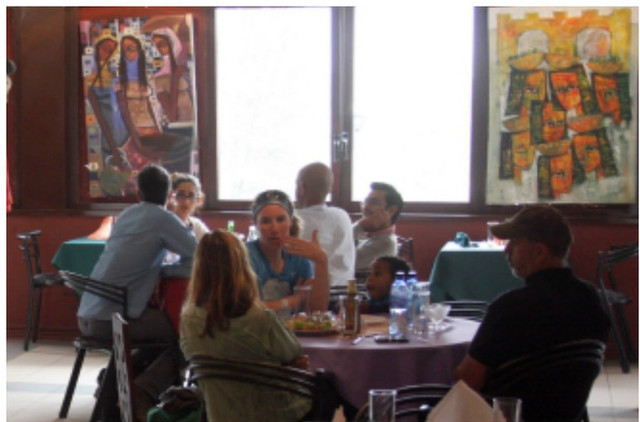 A lunch crowd at Makush Art Gallery and Restaurant in Addia Ababa, popular with foreigners and tourists. (Photo: James Jeffrey)
A lunch crowd at Makush Art Gallery and Restaurant in Addia Ababa, popular with foreigners and tourists. (Photo: James Jeffrey)
By James Jeffrey
July 28, 2014
ADDIS ABABA, Ethiopia — Tesfaye Hiwet started visiting his homeland from the U.S. shortly after the 1991 revolution that brought down Ethiopia’s communist-inspired military dictatorship known as the Derg. One reason was to source art for his Washington-based restaurant and nightclub.
After noticing the lack of galleries in the Ethiopian capital, he moved back to Addis Ababa 12 years ago and opened the Makush Art Gallery and Restaurant, starting with a handful of artists. Nowadays, every wall in Makush is blanketed with vivid Ethiopian paintings depicting scenes ranging from monks praying in the dawn half-light to bustling markets and images of wide-eyed, elongated women.
Addis Ababa has an active art community that can benefit from the lucrative sales at Makush, which now has about 70 artists on its books and a collection of more than 650 paintings.
But not all the city’s artists want to get involved with Makush because of its unabashed commercial focus — at the sacrifice, they argue, of artistic merit. They worry the gallery represents an unfettered art market where lack of analysis and criticism can compromise artistic integrity, drive runaway prices and lead to the prevalence of mediocre art that doesn’t express the true range of artistic talent simmering away.
“Many artists are increasingly enticed to market-driven productions,” said Elizabeth Giorgis, an art historian and director of the Gebre Kristos Desta Center, a modern art museum in Addis Ababa. “The current Ethiopian art market has produced a dark side where prices are ineptly assessed and fixed at exorbitant prices that do not warrant the credibility or skills of the artists.”
But an emergent modern and contemporary art scene in energetic flux is a stark contrast from when Ethiopia had no market at all.
Read more at Aljazeera America »
—
Join the conversation on Twitter and Facebook.

























